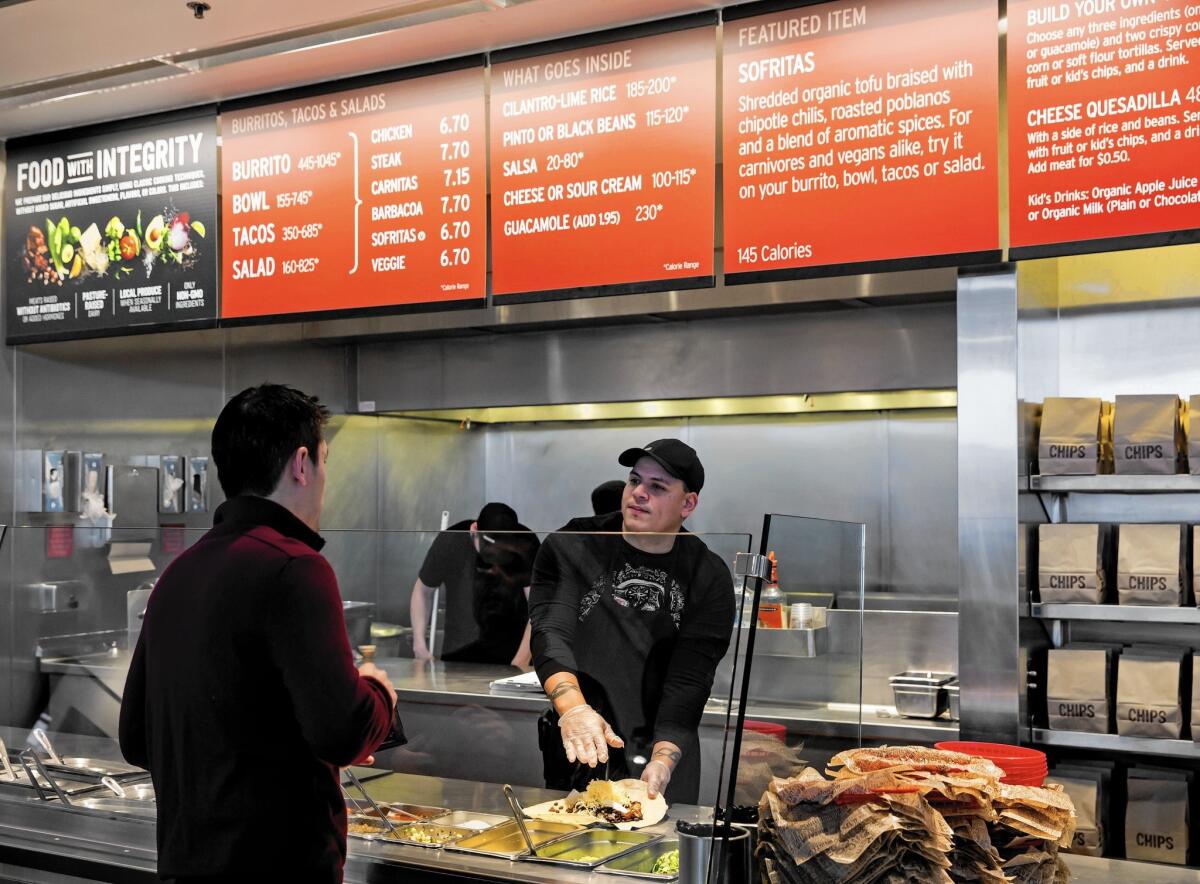Q&A: What went wrong at Chipotle? Food safety expert Trevor Suslow breaks it down

- Share via
Fears of unsafe food have plagued U.S. consumers as new recalls and illness outbreaks appear with disturbing regularity.
Customers avoided Chipotle Mexican Grill Inc. restaurants for months after two E. coli outbreaks and a norovirus incident were tied to the burrito chain in 2015. Since then, the Denver company has struggled and in February staged a high-profile national employee meeting to emphasize safety practices.
On Wednesday, Chipotle projected a first-quarter loss, and executives said they may offer free burritos and other promotions to boost sales.
SIGN UP for the free California Inc. business newsletter >>
In February, the federal Centers for Disease Control and Prevention said the E. coli outbreaks tied to Chipotle restaurants appeared to be over and it was closing its investigation, though it was unable to determine a specific item responsible for the contamination.
Company founder and co-Chief Executive Steve Ells has said Chipotle will spend up to $10 million to help produce safer meat and vegetables from its smaller suppliers and implement the chain’s new food-safety standards.
The Times spoke with Trevor Suslow, extension research specialist in UC Davis’ plant sciences division, about the next steps for Chipotle and the state of food safety in fast-food restaurants. Suslow has worked extensively with the food industry and public health organizations on food-safety issues. Here is an edited excerpt:
What can we learn from Chipotle’s problems?
It’s extremely difficult to know what the contributing factors are unless you’re inside. I would argue because of that, it gives the appearance of not really addressing the underlying causes for at least some of the outbreaks that have been involved. To be honest, that has been somewhat disappointing.
A contributing factor was a systemic issue with food handling, food preparation, employee personal hygiene. They may have great policies for all that, but it gives the appearance that consistent implementation across the different retail outlets wasn’t there. It’s hard to explain otherwise. Because the trace back and the investigation could not pinpoint a primary ingredient that was the source of contamination, it gives the appearance that there were multiple opportunities to cross-contaminate completely different menu item ingredients, so no one place or no one cluster traces back to a single source.
Was Chipotle especially susceptible because of its fresh food emphasis?
Again, very hard to say. I don’t want to be unfair or speculate beyond the information that we have, but certainly it’s been suggested that, with the degree of in-store food preparation of all incoming items, I think it’s potentially much harder to control the consistency of good food handling and you’d be much more likely to be handling meat and poultry, as well as fresh produce, all in close proximity.
We’ve all been there when things get busy and space is limiting and things are tight. It’s hard to be as immaculately consistent as you need to be.
How often do outbreaks occur?
It’s extraordinarily rare. There have been some big ones, some tragic ones. There seems to be higher frequency with certain items than others, but when you think about the volumes that are produced and distributed and marketed at all the different points of consumption, it’s a fraction — a really small fraction.
How has food safety improved?
It’s improved in leaps and generations primarily as technology, as molecular technologies, molecular microbiology and electronic data sharing and analysis of the matching genetic relatedness has improved. The lag time seems to be getting shorter and shorter between realizing there’s an unusual amount of cases. They never would have been able to do that 20 years ago.
So are we safer than we used to be, in terms of food safety?
In general, I think things are safer. I think they’ve become safer as the industry has recognized and accepted the risks and challenges and put practices and procedures in place. We’ve got a long way to go still to make the level of compliance more uniform, better, cheaper, and some of it is simply lack of science and lack of knowledge about the specific link between practices, pathogen biology, exposure. I think there are certainly specific circumstances that go along with some of the opposite. When something goes wrong, the impacts are much worse than they used to be, that’s for sure, but overall, I’d say we’re still safer.
Join the conversation on Facebook >>
Do you think Chipotle is safer now?
Not necessarily. I think that there are changes that will alleviate some of these issues of the individual in-store contamination likelihood, but I guess we’ll wait and see how their consumer base responds if they implement the practices of trying to do treatments that change the fresh nature of their components that might not normally be cooked. The awareness does ripple across the industry. I don’t think anyone assumes, “It’s not going to happen to me.” I know from personal contact that many of similar fast-casual and fast-food restaurants are reassessing their internal operations and their supply chain management.
What more needs to be done to improve food safety in the fast-food and fast-casual restaurant industry?
I think part of it is to really accept the nature of the risks and having the buying community, food service and industry work in a very cooperative partnership with their suppliers to ensure that the practices and preventive measures, the controls, the interventions, all the things you need to be working together, are consistent and implemented throughout.
Twitter: @smasunaga
MORE BUSINESS NEWS
As home-sharing grows, hotels start to worry
Tribune Publishing wins auction for O.C. Register parent
SeaWorld says it will end killer whale breeding program immediately
More to Read
Inside the business of entertainment
The Wide Shot brings you news, analysis and insights on everything from streaming wars to production — and what it all means for the future.
You may occasionally receive promotional content from the Los Angeles Times.











